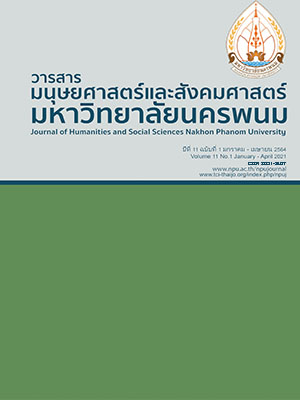The Development of Training Model for Occupational Competency of Telecommunications Technician
Main Article Content
Abstract
The purpose of this research was to Professional development of telecommunication technicians Develop the model of vocational training for telecommunication technicians and study the results of using the form of telecommunication vocational training The research has 5 steps. 1) To improve the competency of telecommunications technicians In which 15 experts assess and make suggestions for improvement. 2) The development of a vocational training model for telecommunication technicians By using the System Approach which has 5 experts assess the suitability and make suggestions 3) The development of the vocational training module for telecommunication technicians for training In which 5 experts evaluated the consistency of behavioral objectives and evaluation criteria, the validity of the tests and the performance evaluation. And the suitability of the training module 4) Vocational vocational training for telecommunication technicians. Regular training is organized by applying training modules to a sample of 30 people. 5) Assessment of trainees In which 3 competency assessors assess the competency through the training By using the evaluation form developed by the researcher together with the competency assessor, which evaluates the performance based on the trace Evidence of knowledge And evidence of skills arising from the training process
The results of the research are 1) The standard of telecommunication technician consists of 5 key functions, 27 units of competency and 76 elements of competency. 2) The form of vocational technician training consists of 6 elements. And is suitable at a good level (= 4.39). 3) The vocational training course for telecommunications technicians consists of 10 learning outcomes. And the evaluation of the suitability is good (
= 4.53). 4) The training results of all 30 participants have achieved scores above 80% and the trainees have The satisfaction with the training process was at a good level (
= 4.58) and 5) the result of competency evaluation. Every trainee can pass the competency evaluation.
Article Details
References
กฤษมันต์ วัฒนาณรงค์. (2553). สมรรถนะวิชาชีพ. กรุงเทพมหานคร : ศูนย์ผลิตตำราเรียน
มหาวิทยาลัยเทคโนโลยีพระจอมเกล้าพระนครเหนือ.
กิดานันท์ มลิทอง. (2543). เทคโนโลยีการศึกษาและนวัตกรรม. กรุงเทพมหานคร : สำนักพิมพ์แห่งจุฬาลงกรณ์มหาวิทยาลัย.
จงกลนี ชุติมาเทวินทร์. (2542). การฝึกอบรมเชิงพัฒนา. กรุงเทพมหานคร : สถาบันพัฒนาการสาธารณสุขอาเซียน มหาวิทยาลัยมหิดล.
จะเด็ด เปาโสภา. (2550). การพัฒนามาตรฐานสมรรถนะ. กรุงเทพมหานคร : สำนักงานคณะกรรมการการอาชีวศึกษา กระทรวงศึกษาธิการ.
ชนะ กสิภาร์. (2542). หลักสูตรฐานสมรรถนะ. (เอกสารประกอบการสอนหลักสูตรดุษฎีบัณฑิต) กรุงเทพมหานคร : มหาวิทยาลัยเทคโนโลยีพระจอมเกล้าพระนครเหนือ.
ณัฐวี อุตกฤษฎ์ และนวพล วงศ์วิวัฒน์ไชย. (2555). การประยุกต์ใช้เทคโนโลยีความเป็นจริงเสริมเพื่อช่วยในการสอนเรื่องตัวอักษรภาษาอังกฤษ A-Z. มหาวิทยาลัยเทคโนโลยีพระจอมเกล้าพระนครเหนือ.
บุญเชิด ดิษสมาน. (2553). การพัฒนารูปแบบการฝึกอบรมสมรรถนะวิชาชีพช่างเครื่องเรือนไม้. วิทยานิพนธ์ปรัชญาดุษฎีบัณฑิต สาขาวิชาเทคโนโลยีเทคนิคศึกษา ภาควิชาครุศาสตร์เทคโนโลยี บัณฑิตวิทยาลัย มหาวิทยาลัยเทคโนโลยีพระจอมเกล้าพระนครเหนือ.
ปิยะชัย จันทรวงศ์ไพศาล. (2551). การค้นหาและวิเคราะห์เจาะลึก Competency ภาคปฏิบัติ.
กรุงเทพมหานคร : สำนักพิมพ์พิมพลักษณ์.
ยุพาศรี ไพรวรรณ. (2553). การพัฒนาหลักสูตรฝึกอบรมการสอนกิจกรรมแนะแนว. วิทยานิพนธ์ครุศาสตร์อุตสาหกรรมดุษฎีบัณฑิต สาขาวิชาวิจัยและพัฒนาหลักสูตร ภาควิชาบริหารเทคนิคศึกษา บัณฑิตวิทยาลัย มหาวิทยาลัยเทคโนโลยีพระจอมเกล้าพระนครเหนือ.
วัฒนา พรหมอุ่น. (2553). Virtual Reality Technology. สืบค้น 7 กรกฎาคม 2553, จาก http://www.docstoc.com/docs/28427384/Virtual-Reality-Technology.
Translated Thai References
Kanok S. (2008). The development of integrated vocational learning and teaching model for vocational education curriculum. Thesis of Doctor of Industrial Education. Program in Vocational and Technical Education Management. Department of Technical Education Management. Graduate College. King Mongkut’s University of Technology North Bangkok. [in Thai]
Kritman W. (2010). Vocational Competency. Bangkok: KMUTNB Textbook Publishing Center. [in Thai]
Kidanan M. (2000). Educational Technology and Innovation. Bangkok: Chuanpim Press. [in Thai]
Jongkolnee C. (1999). Development Training. Bangkok: ASEAN Institute for Health Development. Mahidol University. [in Thai]
Jaded P. (2007). The development of performance standards. Bangkok: Office of the Vocational Education Commission. Ministry of Education. [in Thai]
Chana K. (1999). Competency-Based Approach. (Doctor of Philosophy Teaching Document). Bangkok: King Mongkut’s University of Technology North Bangkok. [in Thai]
Nattavee U. and Nawaphol W. (2012). Development of Learning Media Entitled Hardware Using Augmented Reality Technology. King Mongkut’s University of Technology North Bangkok. [in Thai]
Boonchoen D. (2010). Training format development on occupational competence of wood furniture. Program in Technical Educational Technology. Department of Technical Education. Graduate College. King Mongkut’s University of Technology North Bangkok. [in Thai]
Piyachai J. (2008). Practice for Find and analysis for in-depth competency. Bangkok: Pimluxe. [in Thai]
Yupasri P. (2010). Development of a Guidance Activity Training Program for Teachers. Thesis of Doctor of Industrial Education. Program in Vocational and Technical Education Management. Department of Technical Education Management. Graduate College. King Mongkut’s University of Technology North Bangkok. [in Thai]
Wattana P. (2010) Virtual Reality Technology, Search 7 July 2010, From http://www.docstoc.com/docs/28427384/Virtual-Reality-Technology. [in Thai]


